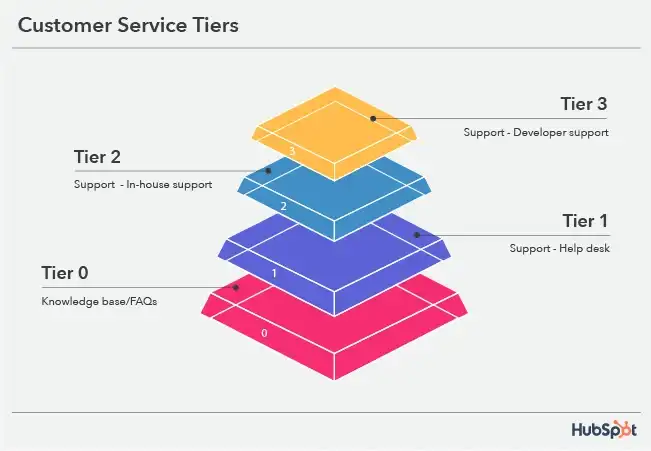What is the Difference Between IT Support Tiers?

What is the Difference Between IT Support Tiers?
The success of any business hinges significantly on the customer experience provided by its support staff. As Jason Sondhi, CEO of Sondhi Solutions says, “Effective customer service not only resolves the issue at hand but also strengthens customer loyalty and trust.”
In fact, research shows that when businesses focus on providing better customer service experiences, they can increase their revenues by 4% to 8% compared to their competitors in the same market.
However, understanding the structured layers through which support is delivered can be puzzling. This breakdown of IT support tiers clarifies the various levels of tech assistance available, ensuring that companies can match customer issues with the appropriate level of technical expertise.
What Is the Main Goal of Service Desk Support?
The primary objective of service desk support is to resolve users’ technical problems promptly and efficiently, thereby ensuring minimal disruption to their business operations and enhancing their overall satisfaction. In fact, research shows that 67% of customers are willing to pay more for a great experience.
In a fast-paced and increasingly digitalized world, service desk support is critical in maintaining the seamless operation of business technologies. This support system plays a vital role in preventing downtime, which can be costly in terms of both money and customer trust.
You Deserve More Than Just Basic IT SupportSondhi Solutions offers multi-tiered support to tackle all your tech troubles. |
What Is Tier 1 Support?
Tier 1 support, often referred to as the first line of defense in service desk support, is crucial in managing the most common and straightforward customer issues.
This level serves as the initial point of contact for users encountering technical problems, ensuring that any user can receive immediate assistance for basic concerns. The support provided at this level includes a variety of tasks, such as:
- Basic software problems
- Password resets
- User configurations
- Documentation help
- Hardware and software troubleshooting

Source: Hubspot
What Is Tier 2 Support?
Tier 2 support provides a more specialized technical response, dealing with complex issues that go beyond the scope of Tier 1 capabilities.
This level of support is staffed by technical specialists who have deeper knowledge of the product or service. They handle problems that require a detailed understanding of the technical infrastructure. Typical responsibilities at this tier include:
- In-depth technical troubleshooting
- Configuration issues
- Software and hardware interactions
- Network troubleshooting
- Support for custom software
| More resources you might like: |
What Is Tier 3 Support?
Tier 3 support is the highest level of support. It involves highly skilled and experienced technical staff who handle the most challenging and critical issues that cannot be resolved at lower tiers. This tier focuses on advanced problem-solving strategies and direct system interventions that may include code modifications, system reconfigurations, or comprehensive hardware repairs.
Tier 3 technicians often work closely with product development teams to suggest improvements and modifications that can prevent future issues, ensuring that the solutions provided are both effective and sustainable.
- Advanced technical troubleshooting
- Critical incident response
- Bug fixes and patch escalations
- Complex network issues
- Coordination with software and hardware vendors
What Is Tier 4 Support?
Tier 4 support, although not a universal tier, typically extends beyond the organization. This external support tier involves collaborations with external vendors and specialized service providers who possess unique expertise in complex technical areas that are beyond the internal team’s capabilities.
These experts are often called upon to tackle issues related to advanced technology systems, proprietary software, or specialized hardware components that require specific knowledge or certifications.
- Vendor-specific support
- Highly specialized and advanced technical consultations
- Outsourced support for products no longer supported in-house
- Collaboration on new development requests
Escalation Guidelines for IT Support Tiers
This table provides clear scenarios and triggers for escalating IT support issues from one tier to the next, helping streamline the support process and ensuring timely resolutions.
| Issue Type | Initial Tier | Escalation Trigger | Escalation Tier |
| Password Reset | Tier 1 | If account lockout policies require administrative intervention | Tier 2 |
| Software Installation | Tier 1 | If installation errors require deeper system knowledge or permissions | Tier 2 |
| Network Connectivity | Tier 2 | If the issue persists after initial troubleshooting or affects multiple users | Tier 3 |
| Database Errors | Tier 2 | If errors involve data corruption or complex system interactions | Tier 3 |
| Critical System Failure | Tier 3 | If failure impacts significant business operations or requires code changes | Tier 4 |
| Hardware Malfunction | Tier 2 | If hardware requires specialized repair or replacement | Tier 3 |
| Vendor-Specific Issue | Tier 3 | If the issue exceeds internal capabilities and involves specialized technology | Tier 4 |
It’s Time to Elevate Your IT Support Experience
According to research from CloudSecureTech, 92% of large organizations opt to outsource their tech support to capitalize on enhanced efficiency and expertise. Sondhi Solutions aligns with this trend by providing tiered IT support that effectively addresses all technical challenges, thus enhancing overall business operations and customer satisfaction.
| Discover Trusted IT Support Services in Indianapolis |
If your business is looking to streamline its service desk support services, consider reaching out to us to schedule a free consultation.


